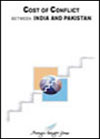Cost of Conflict between India and Pakistan, 2004
 |
"The publication is highly relevant in this time and age. I congratulate the SFG for the high quality of research and analysis that has gone into the publication of the book and the intelligent use of reader-friendly graphics to illustrate various points. I am sure that the publication will prove to be of considerable value to scholars of India �€“ Pakistan relations as well as practitioners of foreign policy.�€ -Shri Yashwant Sinha, Former Minister of External Affairs, India
�€œThis document is of exceptional quality in its comprehensive coverage and analytical strengths. It is the first time that we have such all encompassing information and analysis in one place on the implications of adversarial relationship between India and Pakistan.�€ - Niaz A. Naik, Pakistan�€™s Former Foreign Secretary, Foreword
We�€™ve known it all along �€” the conflict with Pakistan is a lose-lose situation for both sides. But now the report of the Strategic Foresight Group titled �€˜Cost of Conflict between India and Pakistan �€™ has put a figure to it�€� The writing is on the wall �€” investment in people is an investment in peace. - Editorial, The Times of India, February 26, 2004
Findings
India and Pakistan have followed a "swing" model of relations whereby the pendulum of the relationship swings from one end to the other - conflict in May 1998 to peace in February 1999 to conflict in May 1999 to peace in November 2001 to conflict in December 2001 to peace in April 2003 to further peace in January 2004.
The Siachen conflict alone will cost India Rs. 7,200 crores and Pakistan Rs. 1,800 crores in the next five years. Together they will lose about 1,500 soldiers in the next five years in Siachen without fighting a war.
Pakistan's GTP (Gross Terror-economy Product) is Rs. 264 billion or equal to 6.6 per cent of its GDP.
Pakistan's Conflict Economy is more than 10 per cent of GDP. The Conflict Economy includes GTP and military expenditure.
Pakistan's jihadi forces are expected to increase from 200,000 at present to 300,000 at the end of the decade and the army from 620,000 at present to 646,000 at the end of the decade.
The control of Pakistan's military on its economy has enabled military officer's to head Water and Power Development Agency, Electric Supply Corporations of all major cities, Oil and Gas Development Corporation, Pakistan Telecommunication Authority, Pakistan Steel Mills, port Trust of Karachi and Gwadar, National Highway Authority, Tourism Development Corporation, Shipping Corporation, Civil Aviation Authority, Post Office, National Accountability Bureau, Public Service Commission, Life Insurance Corporation and provide Vice Chancellors of major Universities.
The casualties of Kashmir conflict since 1988 to 2000 were 85 per cent Muslims and 11 per cent Hindus.
India and Pakistan have the potential to enjoy a trade of about $1 billion if hostile environment continues and $13.25 billion if peace prevails on a cumulative basis for the next five years (2004-08) resulting in an opportunity loss of $12 billion.
related media coverage
-
India-US Defence Pact
July 17, 2005
-
Post-'01 stand-off cost pegged at $3bn
December 27, 2004
-
The cost of India-Pakistan Conflict
December 24 - 30, 2004
-
Consolidation of SAARC gains vital for India, Pakistan: Report
November 16, 2004
-
VIEW: Who wants peace?
October 10, 2004
-
What's the real cost of sustaining Indo-Pak conflict?
September 4, 2004
-
Cost of Conflict between India and Pakistan
July 12, 2004
-
India must take the lead in fighting terror
June 20, 2004
-
Cost of Conflict between India and Pakistan
May 25, 2004
-
What War will Bring
May 23, 2004
-
India's Crisis of Values
May 13, 2004
-
Think If trade ties were more like cricket...
May 2, 2004
-
Debt of History
April 27, 2004
-
Indo-Pak Conflict: Positive Costs, Zero Benefits
April 20, 2004
-
The cost of conflict between India and Pakistan
March 25, 2004
-
Cost of Conflict Between India and Pakistan
March 15, 2004
-
The shocking calculations
March 11-17, 2004
-
Washington Diary
March 11, 2004
-
Whitepaper on ISI spies in India
March 9, 2004
-
OP-ED: The cost of Pakistan-India conflict
March 6, 2004
-
The wounds of conflict in South Asia
March 6, 2004
-
UPI Hears...
March 3, 2004
-
Plea for another Pakistan-India summit
March 2, 2004
-
The Cost of Indo-Pak conflict
February 29, 2004
-
Social sector will boom if guns fall silent
February 26, 2004
-
The cost of nuclear conflict
February 22, 2004
-
Potential gains from Peace in the Indian-Pakistan Conflict
February 19, 2004
-
India and Pakistan-Economic costs of conflict
February 18, 2004
-
Pakistan's
February 17, 2004
-
Pak terror economy billed at Rs 264 bn
February 16, 2004
-
Book presents cost of Indo-Pak conflict
February 13, 2004
-
The media of India and Pakistan are neither weapons of war nor purveyors of peace
June, 2003
-
Increase in terrorism predicted for South Asia
May 8, 2003
-
�€˜Foresight�€™ into post-war Iraq and oil prices
May 7, 2003
-
Pak-US relations may be rocky till '10: experts
May 5, 2003
-
Shifting Sands: Instability in Undefined Asia
May 2003
-
Beyond the Hard News (op-ed)
April 20, 2003
-
Decline of US may has begun with Iraq war
March 28, 2003
-
The ICPI report: playing with facts
March 28, 2003
-
US is trying to redefine global order
March 28, 2003
-
US will not pressure Indian to roll back its N-arms programme
March 24, 2003
-
India's stealthy reformer takes the floor
February 28, 2003
-
It is a question of unemployment
February 23, 2003
-
India/Pakistan Conflict
May 26, 2002


